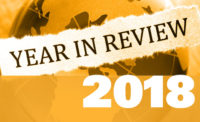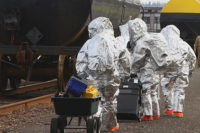Congratulations to Ted Rader who recently completed his first year of medical school. First year med students in the U.S. often endure arduous 12-hour lecture and study days with, on average, faced with a do-or-die test or similar challenge each week of the school year. First year of med school is considered a sprint. The following years of med school and residency are like an endurance marathon with the distance finish line, about six years later, necessary to become a full-fledged physician.
Ted is unique among med students. Ted is one of us. Ted earned his Certified Industrial Hygienist® credential before going to med school. Ted is taking the basics of what a CIH® knows to a much greater understanding. Eventually, Ted will be able to legally do things that we cannot, such as perform surgery.
OSHA health professionals
OSHA 29 CFR 1910.1020(c)(9), Access to employee exposure and medical records, states: “Health Professional means a physician, occupational health nurse, industrial hygienist, toxicologist, or epidemiologist, providing medical or other occupational health services to exposed employees.” Other OSHA standards such as 1910.95(g)(3) occupational noise exposure, specifies the need for an occupational health pro such an otolaryngologist. Proper occupational health requires a team approach where each pro knows the limits of their capabilities.
First aid or medical treatment?
Suppose a worker gets something in their eye and seeks help from a first aid responder. Visual observation by the responder shows a small speck. Flushing with water does not remove the speck. A cotton swab almost removes the speck, but the speck remains. A free edge of the speck is observed under magnification. With a careful hand and the slightest pull, tweezers are used to remove the speck. The worker is relieved of discomfort and returns to their job. Is this scenario considered by OSHA to be first aid or medical treatment?
OSHA 1904.7(b)(5)(ii)(J) and (K) classifies the above scenario as medical treatment. Taking the speck out with tweezers from the eye could be considered surgery, too. The American College of Surgeons states, in part, that: “Surgery is performed for the purpose of structurally altering the human body by incision or destruction of tissues and is part of the practice of medicine.”
When may the destruction of human tissue occur? What is the composition of the speck? Is the speck located in the iris, pupil, cornea, lens, or surrounding muscle? Location makes a difference. Worst case, the speck may be a metal splinter of unknown length that upon removal causes destruction of eye tissue. First aid responsibility does not forgive, or legally absolve from liability, someone who performs acts beyond their limits of capability.
Limits of capability – IH example
Numerous information suggest the limits of industrial hygiene capability. For example, the ACGIH® TLVs® and BEIs® booklet, a nearly obligatory resource for many, if not most workplaces, cautions that information in the booklet should only be interpreted and applied by those “trained in industrial hygiene.” Lincoln Electric’s Safety Data Sheet for Gas Metal Arc Welding products, includes the advice, “Workplace exposure assessments must be conducted by a qualified professional, such as an industrial hygienist.” OSHA 1910.1000(e) air contaminants specifies that, in part, that “Any equipment and/or technical measures used for this purpose must be approved for each particular use by a competent industrial hygienist.” How do we define “trained in industrial hygiene,” “qualified professional, such as industrial hygienist,” or “competent industrial hygienist”?
OSHA1915.7(c)(6) partly addresses this issue and requires on occasion the need for a “Certified Industrial Hygienist.” OSHA added language for a CIH® in their shipyard standard to “make it clear that there may be atmospheric conditions present in the shipyard that cannot be evaluated effectively by a person trained only to the competent person level and that more highly trained individuals may be needed to accurately evaluate an atmosphere.” The competent person must know the limits of their capabilities that triggers the need for a CIH®. Be aware, OSHA 1915.7 may be referenced in tort litigation or other arguments as an example of what qualifies as a trained, qualified, or competent industrial hygienist.
Medical specialty
Industrial hygiene began as a medical specialty in the U.S. in the early 1900s. The first issue of The Journal of Industrial Hygiene was published in May 1919. About a couple decades later, organizations such as ACGIH® and AIHA®, mostly to represent non-medical practitioners, were formed. The more an industrial hygienist learns, the more they are drawn into the medical aspects of what IH is all about. Armed with his CIH®, Ted is going back to the future with his med school learning. Over the coming years, I suspect that Ted will be amazed at what a CIH® could accomplish with expanded limits of capability.
Inverted pyramid
Unfortunately, Ted may be pulled away from his interest in industrial medicine by the time he is a fully fledged physician. The Association of American Medical Colleges (AAMC) suggests that the U.S. is short now of about 20,000 physicians, and by 2034 the shortage gap may extend up to 125,000 physicians. The AAMC predicts there will be critical shortages among medical specialties. Severe shortages among other health professionals such as nurses, medical assistants, physical therapists, and pharmacists are also expected in the future, too.
Part of the problem is the U.S.’s inverted population pyramid, with a rapidly growing bunch of old people at the top with few young people at the bottom. By 2040, there may be over 80 million Americans over the age of 65. Future health care in the U.S., therefore, must shift greatly to geriatric medicine. In the future, Ted may be greatly pressured to replace a patient’s arthritic hips rather than remove health hazards from the workplace.
Scope creep
U.S. states are rapidly proposing laws to allow non-physician health professionals to perform some physician practices, such as allowing an optometrist to perform eye surgery or nurse practitioner to independently diagnose and treat patients. The American Medical Association is working tirelessly to fend off these actions, but the future favors the passage of bills to allow non-physicians to perform prior only physician practices.
Workplace
Scope creep among OHS pros is occurring now and will expand in the future, too. The challenge for OHS pros, and others, is to know when to expand or establish limits of OHS capabilities.




